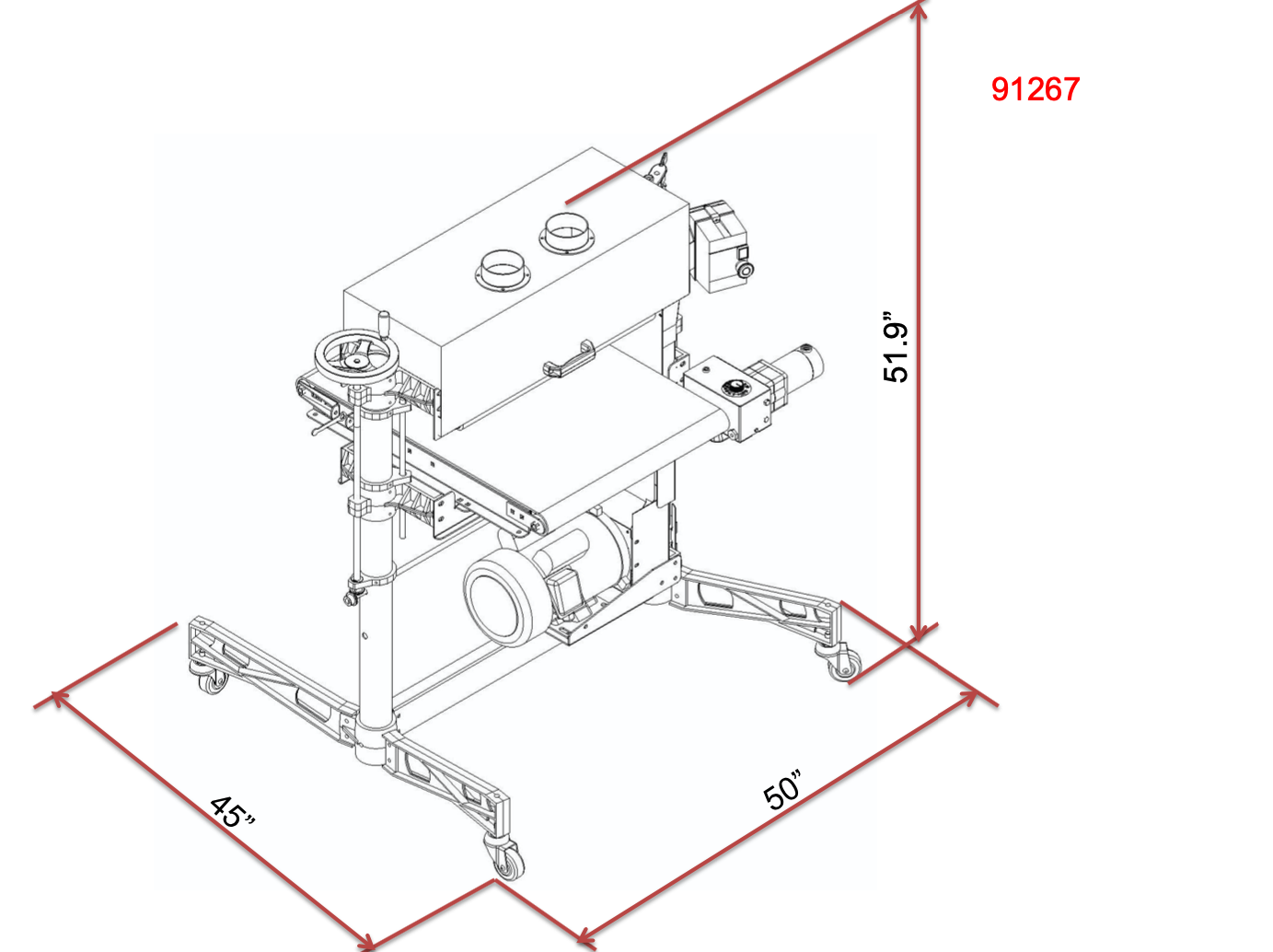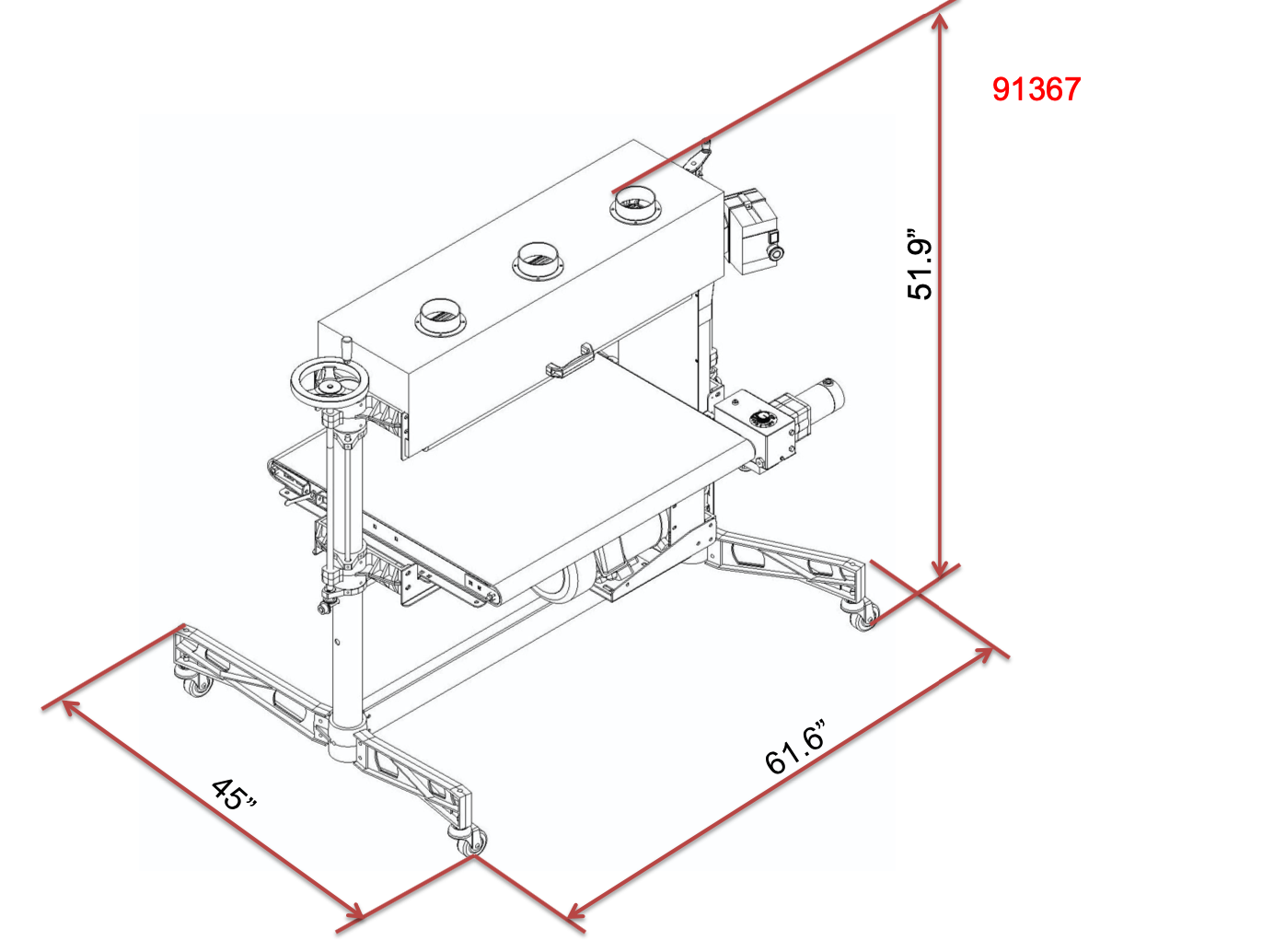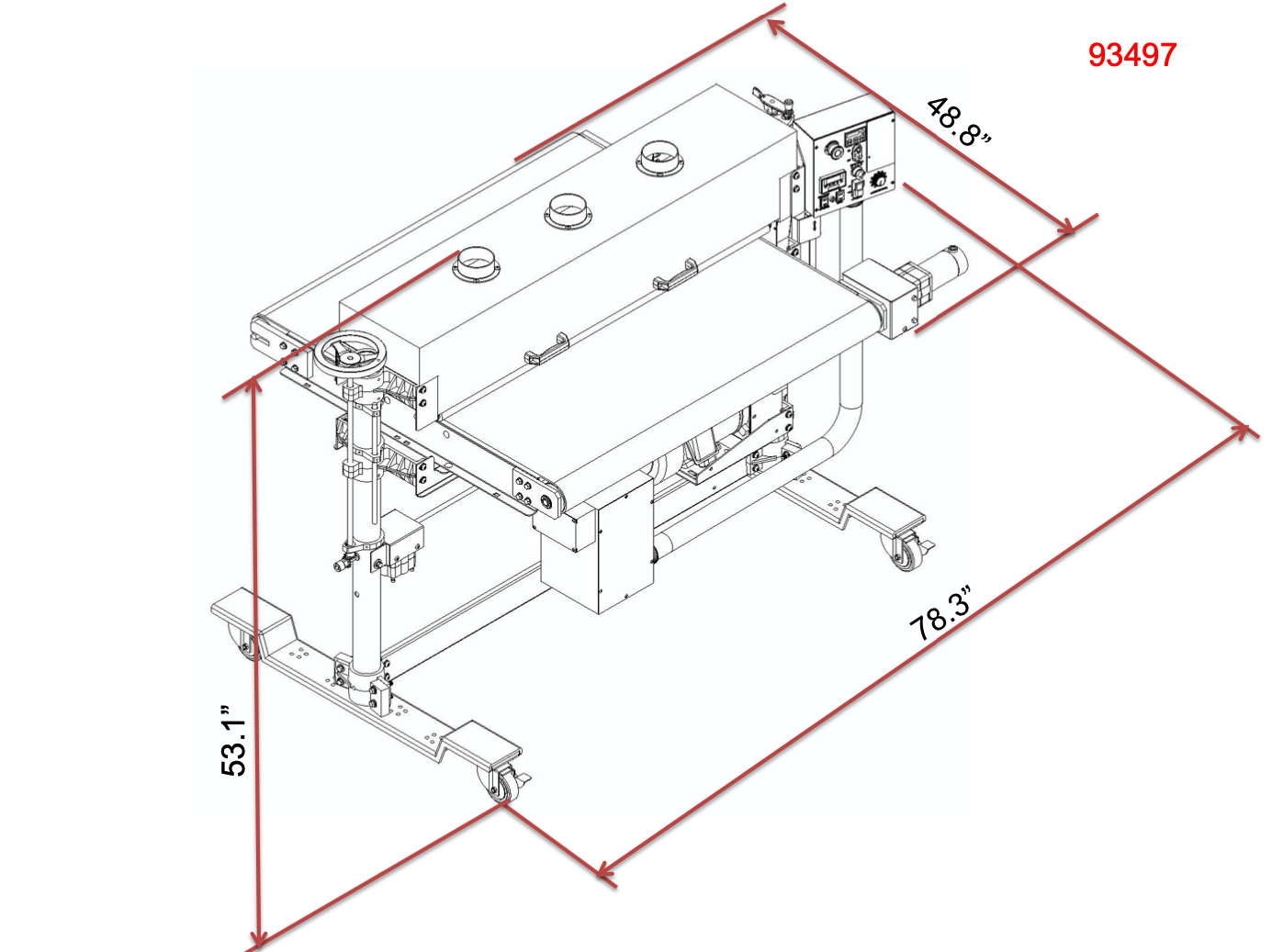Home / Industrial Machines / Superbrushes / Single Brush
SuperBrush Single Brush Sander
SuperMax Tools® offers a wide variety of SuperBrush™ sanders to meet the many needs of any woodworking shop. Our goal is to provide an excellent priced machine yielding an incredible return on investment by creating faster output, reduced rework, and greater product consistency.
- Raw Wood Sanding
- White Wood Sanding
- Break sharp edges
- Blend out minor defects
- Sealer Sanding
- Primer Sanding
- Scuff Sanding
- Profile sanding
- Clean reclaimed wood
- Wire brushing to pull out soft grain to create a textured surface
It’s also available with Two Brush Heads
+$399 Freight
These easy to use machines come with an extremely low learning curve and offer many different features which include: quick change brush heads, infinitely variable brush and conveyor speeds to allow for endless finish possibilities, adjustable tension rollers to prevent stock slippage, and precision height adjustments. Our SuperBrush™ sanders come in sizes ranging from 24″ to 49″ with single and/or double brush head offerings to meet all your finishing needs.
Features of the SuperBrush Single Brush Sanders include:
SuperBrush Benefits
The SuperBrush has these great benefits over hand finishing:
- Faster Output
- Reduce Rework
- Greater Surface Consistency
*Pricing of product subject to change*
Sanding Capacity
Maximum Width: 24″, 36″ or 49″
Minimum Length: 10″
Maximum Thickness: 11″, varies with brush style
Minimum Thickness: 1/32″
Dimensions (H x W x D)
24″ Model: 52″ x 46″ x 35″
36″ Model: 52″ x 58″ x 35″
49″ Model: 50″ x 71″ x 31″
Brush
9″ – 11″ Typical Diameter
Typical Bristle Length
1-½″ – 3″
Speed
Ranged variable, 400-1200 RPM brush
Dust Hood
24″ Model:
- Steel With Hinged Back
- Two (2) 4″ Vacuum Port
- 1200 CFM Minimum
36″ Model:
- Steel With Hinged Back
- Three (3) 4″ Vacuum Ports
- 1800 CFM Minimum
49″ Model:
- Steel With Hinged Back
- Three (3) 4″ Vacuum Ports
- 1800 CFM Minimum
Drive Motor (TEFC)
24″ & 36″ Models: 5HP
49″ Model: 7-½ HP
Power Requirements
*Note: A power cord and plug are not included and need to be sourced locally and installed
24″: 220V 5HP 1ph 40 amp service
36″: 220V 5HP 1ph 40 amp service
49″: 220V 7.5HP 3ph 40 amp service
Shipping Weight (Lbs)
24″ Model: 525
36″ Model: 605
49″ Model: 775
Conveyor Motor
Direct Drive D.C. Motor, infinitely variable, 0-15 FPM
24″ Model: 100 in.-lb. torque
36″ Model: 100 in.-lb. torque
49 Model: 200in.-lb. torque
- Infinitely variable brush speed and conveyor feed rate allows for a wide variety of finishes
- Quickly change brush heads or abrasive loadings
- Fully adjustable tension rollers prevent stock slippage
- Reinforced steel conveyor bed with a poly conveyor belt
- Precision height adjustment
- Bristle Contact Gauge included
SuperBrush 24 (93267 & 91267 )
)
SuperBrush 36 (93367 & 91367)
SuperBrush 49 (93497)
What is a SuperBrush Brush Sander?
A SuperBrush brush sander is a machine that can be equipped with different types of sanding heads to achieve a wide variety of finishes on wood or plastic composite material. It is commonly used for applications that would traditionally be done by hand, such as profile sanding mouldings or raised panel doors, or to achieve labor-intensive finishes like distressing. Unlike a drum sander which can only dimension a flat surface, the bristles on the brushes flex and bend to conform to profiles.
What do the different types of brush do?
The main categories of brush heads are flatter, nylon, and wire. There are many variations of brush heads within those categories, resulting in dozens of brush head options. For example, using a flatter style brush will help you to achieve a hand-sanded finish on profiles like mouldings and raised panel doors. It is also commonly used in raw wood sanding to open the grain for stain, and then used for sealer sanding in between coats of stain or primer simply by changing the grit of flatter strip. Wire brushes are most commonly used to achieve a distressed or weathered finish. Nylon brushes work well for cleaning reclaimed wood or light distressing. These are just a few of the different applications for each brush type.
Wire Brush
This product is used to distress wood. This will give it a wire brushed, reclaimed look. Within this category, there are multiple types of wire brushes based on the type of application you are working with.
Nylon Abrasive
This is a broad category. This can be used for anything from scuff sanding, cleaning barn wood and distressing new boards.
Flatter Brush Head
This is used for raw wood sanding, scuff sanding and in some cases cleaning barn wood. This is the most common brush used for sanding cabinet doors.
How long does it take to change a brush head?
The single head machines are designed for quick and easy brush head changeover. It’s quite simple and most people can change it in under 15 minutes and be up and running again.
What are some of the benefits of a SuperBrush?
Increase Output: SuperBrush sanders are able to run material up to 30ft a minute (depending on the model you choose), much faster than sanding by hand!
Increase Consistency: When hand sanding, an employee is likely going to produce a different result at 8 a.m than he is at 5 p.m. With a SuperBrush sander, the results are the same time after time.
Low Learning Curve: A SuperBrush sander is not difficult to operate. After a short training period, nearly anyone can run a SuperBrush sander.
Versatility: Perhaps the biggest benefit of a SuperBrush sander is its versatility. Vastly different finishes can be achieved by changing the brush head, or more finite changes can be achieved by changing the speed of the conveyor, the RPM of the brush head, or the depth of bristle penetration.
-

An Overview: The SuperBrush Sander
-

An Overview: The SuperBrush Double Brush Sander
-

Changing Brush Heads on the SuperBrush Sander
-

The Value of the SuperBrush
-

Brush Head Install on the SuperBrush Sander
-

Foam Sanding With A SuperBrush Sanding Machine by SuperMax
-

Texturing Pine with the SuperMax Tools’ SuperBrush
-

Texturing Maple With A SuperBrush Sanding Machine | SuperMax Tools SuperBursh Machine Texturing
-

Texturing Cedar Wood With A SuperBrush Sanding Machine
-

Texturing Alder With A SuperBrush Sanding Machine
Purchase Replacement Parts
Open the manual below and click any highlighted part to purchase online
Additional Details
These easy to use machines come with an extremely low learning curve and offer many different features which include: quick change brush heads, infinitely variable brush and conveyor speeds to allow for endless finish possibilities, adjustable tension rollers to prevent stock slippage, and precision height adjustments. Our SuperBrush™ sanders come in sizes ranging from 24″ to 49″ with single and/or double brush head offerings to meet all your finishing needs.
Features of the SuperBrush Single Brush Sanders include:
SuperBrush Benefits
The SuperBrush has these great benefits over hand finishing:
- Faster Output
- Reduce Rework
- Greater Surface Consistency
*Pricing of product subject to change*
Sanding Capacity
Maximum Width: 24″, 36″ or 49″
Minimum Length: 10″
Maximum Thickness: 11″, varies with brush style
Minimum Thickness: 1/32″
Dimensions (H x W x D)
24″ Model: 52″ x 46″ x 35″
36″ Model: 52″ x 58″ x 35″
49″ Model: 50″ x 71″ x 31″
Brush
9″ – 11″ Typical Diameter
Typical Bristle Length
1-½″ – 3″
Speed
Ranged variable, 400-1200 RPM brush
Dust Hood
24″ Model:
- Steel With Hinged Back
- Two (2) 4″ Vacuum Port
- 1200 CFM Minimum
36″ Model:
- Steel With Hinged Back
- Three (3) 4″ Vacuum Ports
- 1800 CFM Minimum
49″ Model:
- Steel With Hinged Back
- Three (3) 4″ Vacuum Ports
- 1800 CFM Minimum
Drive Motor (TEFC)
24″ & 36″ Models: 5HP
49″ Model: 7-½ HP
Power Requirements
*Note: A power cord and plug are not included and need to be sourced locally and installed
24″: 220V 5HP 1ph 40 amp service
36″: 220V 5HP 1ph 40 amp service
49″: 220V 7.5HP 3ph 40 amp service
Shipping Weight (Lbs)
24″ Model: 525
36″ Model: 605
49″ Model: 775
Conveyor Motor
Direct Drive D.C. Motor, infinitely variable, 0-15 FPM
24″ Model: 100 in.-lb. torque
36″ Model: 100 in.-lb. torque
49 Model: 200in.-lb. torque
Features
- Infinitely variable brush speed and conveyor feed rate allows for a wide variety of finishes
- Quickly change brush heads or abrasive loadings
- Fully adjustable tension rollers prevent stock slippage
- Reinforced steel conveyor bed with a poly conveyor belt
- Precision height adjustment
- Bristle Contact Gauge included
Dimensions
SuperBrush 24 (93267 & 91267 )
)
SuperBrush 36 (93367 & 91367)
SuperBrush 49 (93497)
FAQ's
What is a SuperBrush Brush Sander?
A SuperBrush brush sander is a machine that can be equipped with different types of sanding heads to achieve a wide variety of finishes on wood or plastic composite material. It is commonly used for applications that would traditionally be done by hand, such as profile sanding mouldings or raised panel doors, or to achieve labor-intensive finishes like distressing. Unlike a drum sander which can only dimension a flat surface, the bristles on the brushes flex and bend to conform to profiles.
What do the different types of brush do?
The main categories of brush heads are flatter, nylon, and wire. There are many variations of brush heads within those categories, resulting in dozens of brush head options. For example, using a flatter style brush will help you to achieve a hand-sanded finish on profiles like mouldings and raised panel doors. It is also commonly used in raw wood sanding to open the grain for stain, and then used for sealer sanding in between coats of stain or primer simply by changing the grit of flatter strip. Wire brushes are most commonly used to achieve a distressed or weathered finish. Nylon brushes work well for cleaning reclaimed wood or light distressing. These are just a few of the different applications for each brush type.
Wire Brush
This product is used to distress wood. This will give it a wire brushed, reclaimed look. Within this category, there are multiple types of wire brushes based on the type of application you are working with.
Nylon Abrasive
This is a broad category. This can be used for anything from scuff sanding, cleaning barn wood and distressing new boards.
Flatter Brush Head
This is used for raw wood sanding, scuff sanding and in some cases cleaning barn wood. This is the most common brush used for sanding cabinet doors.
How long does it take to change a brush head?
The single head machines are designed for quick and easy brush head changeover. It’s quite simple and most people can change it in under 15 minutes and be up and running again.
What are some of the benefits of a SuperBrush?
Increase Output: SuperBrush sanders are able to run material up to 30ft a minute (depending on the model you choose), much faster than sanding by hand!
Increase Consistency: When hand sanding, an employee is likely going to produce a different result at 8 a.m than he is at 5 p.m. With a SuperBrush sander, the results are the same time after time.
Low Learning Curve: A SuperBrush sander is not difficult to operate. After a short training period, nearly anyone can run a SuperBrush sander.
Versatility: Perhaps the biggest benefit of a SuperBrush sander is its versatility. Vastly different finishes can be achieved by changing the brush head, or more finite changes can be achieved by changing the speed of the conveyor, the RPM of the brush head, or the depth of bristle penetration.
Videos
-

An Overview: The SuperBrush Sander
-

An Overview: The SuperBrush Double Brush Sander
-

Changing Brush Heads on the SuperBrush Sander
-

The Value of the SuperBrush
-

Brush Head Install on the SuperBrush Sander
-

Foam Sanding With A SuperBrush Sanding Machine by SuperMax
-

Texturing Pine with the SuperMax Tools’ SuperBrush
-

Texturing Maple With A SuperBrush Sanding Machine | SuperMax Tools SuperBursh Machine Texturing
-

Texturing Cedar Wood With A SuperBrush Sanding Machine
-

Texturing Alder With A SuperBrush Sanding Machine
Parts
Purchase Replacement Parts
Open the manual below and click any highlighted part to purchase online









